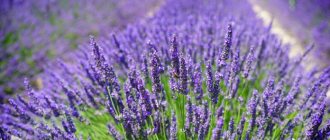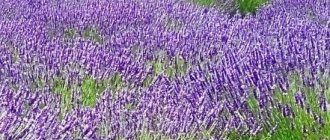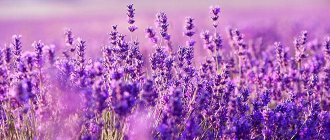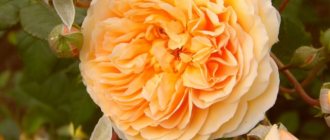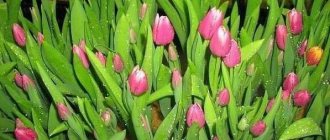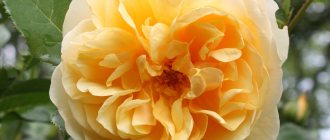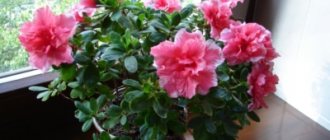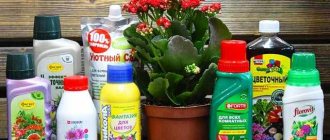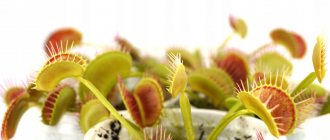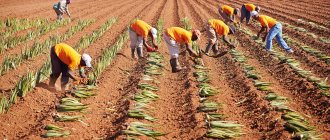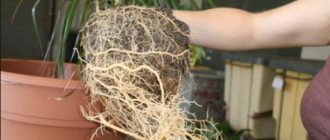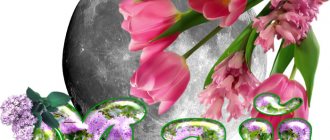Lavender as a flower crop
Lavender, or Lavandula, is a non-herbaceous plant. This is a shrub, a representative of the Lamiaceae species, which unites about 30 species. They can be found in Africa, Arabia, southern Europe, India, and Australia.
Interesting. Lavender is a symbol of France, or more precisely of one part of it - Provence. This is because during the Roman Empire, those same lands were used for growing this plant. It was considered very valuable and was sold for almost its weight in gold.
The first name of the flower comes from the Latin “lava”, which means “to wash”. This is because the ancient Greeks used it not only for medicinal purposes, but also for washing their clothes. A little later, the French christened the fragrant flora lavandre, and it was this name that spread throughout the world.
Features of lavender
Lavender is an evergreen perennial shrub whose roots are fibrous and woody and can reach a depth of about 200 centimeters into the soil. It has many stems, reaching a height of about 0.6 m, which become woody in the lower part. The opposite sessile leaf plates have a linear shape and a greenish-silver color, with soft pubescence on their surface.
Fragrant flowers are collected in interrupted spike-shaped inflorescences of 6–10 pieces in whorls; they are colored lilac-blue or blue. Inflorescences are formed in the upper part of leafless shoots. Lavender begins to bloom in mid-summer.
This plant is considered an excellent honey plant. If its seed material is stored correctly, then it will have excellent germination even after many years. This shrub is considered a relative of the following crops: basil, mint, lemon balm, motherwort, oregano, sage and rosemary.
Types of lavender
Rose seeds - what they look like, can you germinate them at home?
In total, this genus unites as many as 30 species. Of these, only two are most often cultivated. Namely:
- Lavender angustifolia (also known as English and medicinal);
- Lavender broadleaf (or French).
French lavender
English lavender is the most widespread throughout the world. It has narrow leaves and spike-shaped inflorescences. This is what is grown on the streets in the middle zone. This is because it can easily overwinter in the open ground; it does not have to be dug up and transplanted into the house.
The French look is much more capricious. It has wider leaves and shorter inflorescences. The most important difference is that French lavender is killed by cold temperatures below -10 °C. That’s why it is often grown at home; when grown in a garden, it must be dug up and moved indoors for the winter.
Interesting. Russian gardeners use two more types (albeit much less frequently than the first): Dutch, or hybrid, and serrated.
Brief description of cultivation
- Landing . Seeds for seedlings are sown in February–March, in open ground in October, while seedlings are transplanted into open soil in the last days of May or the first days of June.
- Bloom . It begins in the middle of summer.
- Illumination . Needs plenty of bright sunlight.
- Soil . It should be dry, well permeable to water and air, loamy or sandy with a pH of 6.5–7.5.
- Watering . Lavender must be watered systematically and abundantly. During a prolonged dry period, the frequency of watering is increased.
- Fertilizer . Fertilizing is carried out twice during the growing season. In the spring, a complex mineral fertilizer with a high nitrogen content is applied to the soil, and in the fall, a phosphorus-potassium fertilizer is applied.
- Hilling up . Old plants need to be hilled up twice a season; this is done in spring and autumn.
- Trimming . When the bush fades, all its inflorescences are removed, and in the autumn the branches are shortened. After the plant is 10 years old, it is rejuvenated by cutting off all branches at a height of 50 mm from the ground surface.
- Reproduction . By seed method, as well as by cuttings, layering and dividing the bush.
- Harmful insects . Cicadas, rainbow beetles and aphids.
- Diseases . Gray rot.
Benefits and Applications
Hydrangea seeds - what they look like and whether it is possible to grow seedlings from them at home
Even the ancient Greeks noted the benefits of this flowering plant. As time passed, the boundaries of people’s knowledge about the world expanded, and to this day there is no doubt about the beneficial qualities of lavender.
The most important thing for medicine in this flower is its essential oil. It can be obtained by squeezing the entire above-ground part of the flora (and not just from the flowers, as some believe). The oil has a rich composition: it contains linalool, coumarins, geraniol, borneol, and other useful elements. Thanks to them, lavender essential oil can be used in the following ways:
- For healing abrasions and cuts.
- For dizziness, headaches.
- For insomnia and nervous disorders.
- For toothache.
- To get rid of swelling.
- For discomfort in the stomach and intestines.
- As an anthelmintic.
The flower is used in folk medicine in different ways: lavender seeds, its sprouts, flowers, and leaves are used. Teas and poultices are made from it. It is added to ointments and baths are taken with it. Lavender oil can be used for aromatherapy.
Aromatherapy oil
Moreover, official, scientifically proven medicine also uses this flora. True, in this case, flower extract is more often used.
Where to start - preparing seeds for sowing
In nature, lavender seeds undergo special preparation by humidity and temperature. They form and ripen in late August or early September, and then fall to the soil surface. Autumn rains “draw” them to a shallow depth, where they remain throughout the winter. Low temperatures contribute to the destruction of the dense shell of the seed and the awakening of vitality in it.
It is this principle that should be used when preparing lavender seeds for sowing. Gardeners call it “stratification.” You need to start preparing in the fall, immediately after collecting or purchasing the variety you like. To do this, the seeds are mixed with slightly moistened sand, poured into convenient containers with a tight lid and placed in the vegetable section of the refrigerator. Stratification of lavender seeds lasts for at least 2 months.
During this time, the seed shell will become thinner, and the tiny sprout of the future lavender will gain strength and harden inside another whole seed. This will strengthen the plant’s natural immunity - it will easily tolerate short-term cold snaps after germination.
IMPORTANT
During stratification, the container with seeds must be periodically removed from the refrigerator and ventilated - open the lid, periodically moisten the sand.
Read more about Methods for stratifying lavender seeds
Video “Lavender from seeds - secrets of growing”
Lavender varieties for home cultivation
Geranium seeds - what they look like and how to sow them for seedlings
Lavender is a flower that can be grown both in the garden and at home. In this case, for the second purpose, the French type of flower, jagged or hybrid, is usually chosen. They are small and afraid of frost, so in the middle zone it is better to immediately grow them at home. Among the variety of varieties, the following are especially interesting:
- Helmsdale. This is a variety of broadleaf lavender. It differs in the color of the flowers - it is not lilac, rather burgundy.
- Alba. This variety is a variety of Dutch lavender. Its difference is white flowers.
- Sawyers. This is also a hybrid lavender, the flowers of which have a purple tint.
Variety Sawyers
- Royal Crown is a variety of jagged lavender with soft lilac flowers.
Stratification of lavender seeds at home
For lavender, cold seed stratification is necessary. Without this procedure they simply will not sprout. Ideally, if you stratify the seeds for 2–2.5 months, less is possible, but not less than 1 month. The longer the stratification time, the better for the plant.
There are two known options for stratification - natural and artificial.
Natural stratification means that the seeds are under snow cover all winter. They can be sown directly on the ground or sown in containers that will be under the snow. When the time comes to start growing seedlings, you take out such a container and bring it indoors. It's a little complicated, but it's the most natural and best option for the plant. I haven’t tried this method for lavender yet, because we have such snowdrifts in winter that it will be difficult, although possible, to get to the ground and find a small container.
Artificial stratification is the treatment of seeds with cold for a long time immediately before sowing. I artificially stratify in a cool, frost-free cellar. Everything is growing successfully.
Photo: Stratification of seeds is a mandatory process.
Seeds can be kept in the cold either already sown in seedling containers, or mixed with river sand or soil substrate. Seedling containers must be covered with polyethylene or a lid so that the surface of the soil does not dry out or freeze, but is always slightly damp. Pour the seeds mixed with sand or substrate into a plastic or craft bag and tie it.
The ideal temperature for cold treatment will be from + 5 to + 6 degrees. There is no need to freeze the seeds. It is necessary to ensure a long cooling phase.
How to collect seeds for sowing
Gardeners prefer propagating lavender through seeds. You can get them in two ways: by collecting them yourself and by choosing them in the store. Each case has its own subtleties that you need to know.
Collection
You can collect fully bloomed inflorescences in the garden (or by buying a bouquet with them in the store) and dry them. After this, small seeds will fall off.
Lavender seeds have one characteristic feature - amazing germination. Even after five years from collection, they can sprout. But only with proper storage (in an airtight container) and germination.
Purchase
It is difficult to determine from the seeds themselves whether the variety is sold in a paper bag or not. In order not to be surprised by the replacement of a flower after the sown seeds have sprouted, first of all you need to look at the price. The more interesting and beautiful the plant, the more expensive its seeds will be. They don't come cheap.
Lavender seeds from the store
The second point that you should definitely pay attention to is the information on the packaging. It should contain:
- Variety name;
- Manufacturer;
- Recommendations for care.
Selection and preparation of seeds for growing lavender seedlings
Seeds of perennial and annual varieties of lavender are grown according to the same principle.
- Seeds of perennial lavender require mandatory stratification. In my opinion, this makes the growing process a little more difficult. You need to be patient and wait a few months before you see the shoots. Overall, lavender is quite easy to grow.
- Lavender seeds can be purchased at the store or grown yourself. When purchasing, pay attention to the manufacturer, price and expiration date.
Photo: Seeds can be stored for quite a long time.
- Choose seeds from well-known companies that offer a good range of different plant species. Remember that good seeds cannot be cheap. If the seeds are cheap or are on sale, then there is a high probability that either they will not germinate, or they will not be what is stated on the package (re-grade). You can take a risk buying, but be prepared for surprises.
- When collecting seeds yourself, make sure that the inflorescence is completely dry and only then store the seeds.
- The seeds have a fairly long shelf life; they retain their germination capacity for up to 5 years. Provided that you store them correctly and then follow all agricultural practices when planting and growing seedlings.
- Seeds should be stored in sealed paper packaging in a dark, cool place. Not necessarily the refrigerator. It can be on the mezzanine if it is an apartment, in a cool basement or room if it is a private house. I don’t recommend putting them in plastic zip bags; they can suffocate there, especially during long-term storage. And if they haven’t dried well, mold may develop. Then all your efforts will be in vain.
Photo: Packaging for seeds must be airtight.
Seedling care
In order for a lavender seed to produce strong, healthy shoots, you must follow a number of rules for caring for it. In particular, these are:
- Light. Lavender is an extremely light-loving plant, so under no circumstances should it be placed in the shade.
- Warm. The flower will not like either heat or cold - temperature readings should vary between 15-21 °C.
- Picking. Diving is transplanting sprouts into a larger container. It is more convenient to germinate seeds in a shallow box. As soon as the lavender sprouts produce their first pair of true leaves, they need to be transplanted into a deeper pot. It can be separate or shared (with a large distance between the seedlings), but it is quite spacious in any case. This is because the small-looking sprout has quite strong roots, which are cramped in the germination vessel.
Pests and diseases of lavender
When grown in open soil, lavender is very resistant to harmful insects and diseases. However, problems can arise with it too. In some cases, the bush is affected by gray rot, or rainbow beetles or slobbering pennies (leafhoppers) settle on it.
If pests have settled on the bush, you can get rid of them by collecting insects manually. Then be sure to replace the mulching layer under the bush. The development of gray rot is facilitated by regular stagnation of liquid in the soil, which can be caused by excessively frequent and very heavy watering or prolonged rains.
This disease cannot be treated, so it is recommended to dig up and destroy the affected bush. If the disease is at the initial stage of development, then you can try to save the lavender; to do this, immediately after detection, all affected parts of the bush are cut out. And then the watering regime must be adjusted.
What is needed for seed germination
When the seeds of fragrant flora are sown in the ground, they do not yet require replanting, fertilizing and many other conditions. So far they have only two requirements, but they will have to be complied with:
- Lighting. Lavender seeds need about 10 hours of daylight per day. If the weather does not allow the condition to be fulfilled naturally, the seedlings will have to be illuminated.
Additional illumination of crops
- Temperature. For germination, you must strictly adhere to the temperature conditions indicated above.
Reproduction methods
Lavender can be grown from seeds, and also propagated by layering, dividing the bush and cuttings. How to grow it from seeds is described in great detail above.
Propagation by cuttings
This propagation method is suitable for those who already have lavender on their site or have the opportunity to get its lignified annual shoot. The stem is cut into lengths from 80 to 100 mm.
The resulting cuttings are planted for rooting in a loose, moistened substrate, while their lower cut is buried by approximately 20–30 mm. They are covered with transparent glass jars on top. It will be possible to remove the shelter only after the roots of the cuttings grow.
Dividing the bush
To propagate the crop, the method of dividing the bush is also used. However, the plant should be prepared for this procedure. Select a mature, overgrown shrub. With the onset of autumn, when it fades, it should be pruned to a height of about 10 centimeters, after which it is hilled high, trying to fill the entire space between the stems with soil. In spring, the plant is hilled again. Throughout the summer, the bush produces abundant growth.
With the onset of autumn, the bush is removed from the ground and divided into several parts with well-developed roots and stems. Next, the divisions are planted in a new place in separate holes.
Reproduction by layering
To propagate the shrub by layering, in spring you should select several stems, bend them and place them in grooves 30 to 40 mm deep, made in the soil near the plant. Fix the shoots in this position, cover them with soil and water well.
During the summer period, make sure that the soil above the layering is always slightly moist. It is possible to separate the cuttings that have given roots from the bush only with the onset of the next spring. Next, the cuttings are dug up and planted in a permanent place.
Instructions for sowing seedlings
With a flower such as English lavender, growing from seeds at home requires adherence to a certain order and rules. However, with other species everything is the same.
Selection of seed
You can collect the seeds yourself or buy them in the store. In any case, they must meet the following criteria:
- To be collected from fully bloomed inflorescences.
- Properly stored at average temperature (not frost or heat), in a closed container.
- Not be damp or spoiled by pests.
- When buying, don't be cheap.
Seed stratification
Even if chosen correctly, a lavender seed will not sprout on its own. He needs stratification. This is a natural “launch” of the seed growth mechanism by exposing it to critical temperatures. Moreover, it can be carried out both at high and low degrees. In the case of this particular flora, stratification is carried out only by cold.
And there is one peculiarity. It is not enough just to put the seed in the refrigerator for a minute - the exposure to frost should last quite a long time.
What is stratification?
Stratification is carried out in two ways: natural and artificial. The first is to sow the seed immediately into open soil before winter.
To grow lavender from seeds for seedlings at home, you need to know how seeds are artificially stratified. This means that they should be kept in the cold for at least a month and a half before sowing. More is better. This procedure is carried out as follows: the seed is mixed with sand or soil and placed in a closed container. It is sent to the refrigerator for at least 8 weeks, at a temperature of about +5 °C. But the seed will not survive freezing.
Seed stratification in the refrigerator
Where to sow the seeds
In addition to other preparations for sowing, the gardener is faced with the question of choosing a container and soil.
Lavender needs loose, nutritious soil. The easiest way is to buy a ready-made mixture for seedlings or a universal one for indoor plants in the store. But before germination, it is recommended to bake it in the oven.
The container should be wide, spacious, and shallow - no more than a cm in depth. It will not be possible to make your life easier and germinate a flower in a cassette - this method is not suitable for it.
Sowing
The sowing itself should be carried out according to the following step-by-step instructions:
- The calcined substrate is placed in the container. It cannot be crushed; it must be loose.
- The soil must be well sprayed with water from a spray bottle.
- Flower seeds are laid out on top of the soil quite rarely - with indentations of at least 2 cm from each other.
- They need to be covered with soil on top too, sifting it from above. The top layer of soil should be 2-3 mm.
- After sowing, be sure to make a greenhouse by covering the container with cling film.
Transplanting seedlings into open ground
During the first year of germination, you should not expect flowers or, in fact, a smell from the fragrant flora. She will spend this time forming roots and will bloom only next year. With the onset of warmer weather, the sprouts can and should be transplanted outside. How to plant lavender seedlings according to the rules:
- The place for sprouts needs a sunny, warm place.
- The perennial prefers sandy-clay soil.
- The soil for lavender must be fertilized with mineral fertilizer before planting.
- The spaces between the bushes should be at least 30 centimeters (preferably all 40).
- Lavender seedlings need to be hardened off before replanting. Pots with it should be taken outside for several hours during the week.
Lavender seedlings outside
When to sow lavender for seedlings
It is recommended to start sowing lavender for seedlings from mid-February to mid-March. The choice of a specific time and day depends on your region, the location of the site and the conditions under which the seedlings are kept.
| Advice. Anyone who lives in an apartment and goes to the dacha only when the snow melts can plant later so that the seedlings do not outgrow. A resident of a private house, if he has a greenhouse, can plant earlier. |
Container for planting
It is advisable to choose a wide and shallow container, no more than 7–8 cm deep. Planting in peat tablets is not recommended.
What kind of soil does lavender like?
Fertile, loose soil is ideal. Any ready-made soil mixture intended for seedlings, or “universal soil” from the store. Before planting, water the soil with a medium solution of potassium permanganate or a solution of phytosporin, diluted according to the instructions.
Sowing seeds directly into the ground
Lilac flowers can be grown more simply, without preparing seedlings. You need to know how to properly plant lavender using seeds.
Landing dates
In order for the lavender seed to begin to grow, it must be stimulated by cold. For seedlings, you have to keep the seed in the refrigerator. When sowing directly in open ground, you don’t have to mess around with it directly - it is carried out in the fall, in October, stratification will take place naturally in the winter.
Loosening and fertilizing
After wintering during the growing season, lavender must be fed. It is better to choose fertilizers high in potassium rather than nitrogen. Otherwise, the bush will stretch strongly upward, but will produce few buds.
This flora also needs to be cultivated. It needs to be loosened after winter and also mulched. Mulching is the creation of a layer on top of the soil, which helps moisture not evaporate so quickly. Fallen leaves are suitable for these purposes. Do not mulch the ground right down to the lavender root.
Mulching lavender bushes
Watering
This flower loves water. It needs to be watered regularly, not allowing the soil to dry out. However, thanks to mulching, the plant will not require so much water. Watering most likely will not be necessary every day.
Caring for a young plant
During the first year of life in open ground, lavender should not be allowed to bloom; it is recommended to pick off all inflorescences. This is because at this time the root of the flora must become stronger and adapt to the new location.
Preparing for winter
English lavender can easily withstand frosts down to -25-30°C. But without additional shelter, the flower may not survive such low temperatures.
First, you need to prune the bush. Only 4-5 young shoots are left on it, the rest is cut off.
Secondly, even before the first frost, the bush needs to be tightly covered with spruce branches. Fallen leaves cannot be used - there is a high chance of rot occurring. You can cover crops with leaves. When the first snow falls, it is recommended to separately heat it in a dense layer onto makeshift shelters. This will give the plant the opportunity to survive the winter safely.
Care and cultivation of seedlings
In about two weeks, the first lavender shoots will begin to appear. They are cared for in the same way as seedlings of any other seedlings:
- Gradually remove the shelter so that the seedlings get used to the open air.
- Provide good lighting without direct sunlight. In winter, the days are short, so seedlings will need additional lighting in the morning and evening.
- Monitor soil moisture. The soil is moistened with settled water using a sprayer. The soil should not be too wet, otherwise the seedlings will be affected by fungal diseases or the roots will simply rot.
Picking
When the second or third true leaf appears, the lavender is picked, that is, planted in separate pots. For picking, you can use disposable cups or cassettes
Picking procedure:
- Pre-water the seedlings.
- Fill cassettes or cups with substrate. The same soil as for crops is suitable.
- Make holes in the soil.
- Using a small shovel or a handy tool, dig up a seedling along with a lump of earth and place it in the hole.
- Sprinkle soil up to the cotyledon leaves, water carefully and top up with soil if necessary.
After picking, keep the lavender in the shade for the first day, and then put it back in a well-lit place.
Watering and fertilizing
Water lavender seedlings as needed, preventing the soil from drying out. Two weeks after picking, the bushes are fed with mineral fertilizers with a predominance of nitrogen.
If possible, grow lavender seedlings on a closed loggia or veranda, where it is not very hot and light. This is necessary so that young plants do not stretch out.
Caring for lavender in a pot
This flower can also be grown as a houseplant. Growing lavender from seeds in this case will be similar to how it is done for seedlings. In the future there will be only a few special points for flower care:
- Indoor fragrant flora can more easily tolerate dry soil than excessive humidity.
- The room with lavender will have to be ventilated often. In winter, you should definitely take the flower to another room. The frost will kill him.
- At the bottom of the pot you must create a layer of expanded clay drainage.
- Houseplants need 6-8 hours of daylight. It is best to place the flowerpot with it on the sunny side. In winter, additional illumination with a special lamp may be required.
Lavender in a pot at home
In general, lavender is not a fussy plant. If all the necessary conditions are met, the seeds will quickly produce seedlings, and those, over time, will become lush bushes. Soon a person’s apartment or dacha will be decorated with a bush with incredibly fragrant flowers.
Planting lavender seedlings in open ground
Since lavender grows in mountainous areas, it loves good light and sandy loam alkaline soils. When digging a bed, add a glass of dolomite flour to each square meter of the bed if the soil is neutral and three glasses if it is acidic. Be sure to add sand to the soil (one bucket per 1 sq. m).
You will be interested to know: Picking marigold seedlings: when and how to pick correctly
The holes for planting lavender should be slightly wider and deeper than the size of the glasses. The distance between the holes depends on the height of future adult lavender bushes. To create a lavender hedge, plant the bushes at a distance equal to half the height of the plants.
Attention! Perennial lavender grown from seeds will grow green mass in the first year, and will bloom only in the second year.
After planting, do not forget to water the plants.
Lavender. Planting and care in open ground and at home: photos and advice from experienced gardeners
If you want peace, tranquility and good warmth to reign in your home, and your soul to always be light and joyful, plant lavender in your garden.
This beautifully flowering ornamental shrub ranks first in the medicinal aroma gardens that are so widespread in Western Europe and East Asia.
Its unusual smell calms, calms and evokes the most positive emotions even in very irritable people.
Lavender flowers are used in folk and traditional medicine to treat a number of diseases (read about this below).
Today, many amateur gardeners are engaged in growing lavender. This beautiful plant takes root well in a new place and requires minimal care.
In this article we will tell you in detail about lavender and how to plant it and care for it.
FEATURES AND DESCRIPTION OF THE PLANT
Biological portrait . Lavender is a perennial evergreen multi-stemmed shrub belonging to the Lamiaceae family. Plant height does not exceed 60 cm.
The lower branches are woody and highly branched. They form multiple young shoots with strong silvery pubescence. The oblong, narrow leaves with rolled edges, 4–6 cm long, are also covered with thin villi.
The root of lavender is taproot, going quite deep into the soil, and fibrous at the top.
The bluish-purple flowers are collected in spike-shaped inflorescences. They emit a very strong and surprisingly delicate bitter-wormwood aroma. Some types of lavender may have white or creamy yellow flowers.
Most species are heat-loving and will not grow in our climate. Only English lavender is highly frost-resistant (up to – 30 degrees). In the garden, lavender bushes can grow in one place for up to 40 years if they are pruned correctly.
BENEFICIAL PROPERTIES OF LAVENDER
Lavender has unique healing properties.
The presence of a large amount of antioxidants in the flowers and leaves of the plant helps reduce stress hormones in the human body. Therefore, lavender decoctions and teas can be used to treat insomnia, increased irritability, fatigue, neuroses and vegetative-vascular dystonia.
You can simply inhale the aroma of flowers or lavender oil, and this will immediately bring pleasant calm and relaxation.
The high content of various organic compounds and antioxidants helps reduce and stabilize blood pressure. Lavender extracts improve blood circulation, primarily to the brain, and prevent the occurrence of heart attacks and strokes.
The presence of natural antibiotics in plant tissues allows the use of lavender decoction to treat gastrointestinal diseases (gastritis, ulcers, indigestion, intestinal inflammation, etc.).
Lavender oil perfectly heals purulent wounds and treats various skin diseases.
Lavender is widely used in cosmetology for the manufacture of creams, lotions, perfumes and colognes.
Lavender baths not only calm the nervous system, but also rejuvenate the skin.
TYPES AND VARIETIES OF LAVENDER
There are several dozen types of lavender. The most common are narrow-leaved, serrated, broad-leaved, multi-cut .
But in our climate, only the most popular frost-resistant variety of angustifolia lavender can be grown - English .
It takes root well both in open ground and at home - when grown in a pot.
English lavender is a low bush (35 - 60 cm in height) with many branched stems (one bush can form up to 400 vertical stems).
The stems and leaves of English lavender are covered with silvery pubescence.
According to experts, the best variety of English lavender is Manstead .
Its leaves are bright green with silver fluff. The inflorescences are very large. They rise above the stem and look like bright blue candles with a purple tint. The aroma of flowers is very strong, and at the same time subtle and delicate.
The flowering of English lavender of the Manstead begins in the first ten days of June and continues until the end of August. It is this variety, as the most decorative, that landscape designers most often use in their compositions.
LAVENDER: PLANTING AND CARE
We told you about the biological features and types of lavender. Now let's look at how to properly plant and care for lavender in the open ground and at home.
PLANTING NARROW-LEAFED LAVENDER IN OPEN GROUND
Choosing a location. Lavender is a light-loving plant, so you need to choose an open, well-lit area for it.
Lavender does not tolerate close groundwater, so it must be planted in beds or flower beds 40–50 cm high.
Soils. Lavender loves loose, light, fertile, well-drained soils with a neutral environmental reaction.
It will not grow on heavy clay and acidic soil.
Acidic soil must first be neutralized with dolomite flour, adding it under digging (at the rate of 5 kg per 6 sq. m of plot).
Acidic soil is usually heavy and clayey. Therefore, two weeks after deoxidation, you need to improve its structure by adding for re-digging (per 1 sq. m): two buckets of compost and sand, a bucket of leaf soil and half a bucket of wood ash.
Landing dates. The best time for planting lavender seedlings in open ground is spring (early May). In autumn, seedlings can be planted from mid-September to early October.
Planting lavender. Create beds for planting lavender. Dig planting holes with a depth and diameter of 15 cm at a distance of 60 - 70 cm from each other. The distance between rows is at least 80 cm (remember that lavender bushes grow quickly).
Prepare planting soil from compost, sand and leaf soil. Add 1.5 tbsp to each hole. spoons of superphosphate, 1 tbsp. a spoonful of potassium sulfate and a glass of wood ash.
Plant the plants and cover them with the prepared planting mixture.
Water the lavender seedlings with warm water (half a watering can for each) and mulch the bed with straw or freshly cut grass. The mulch layer will retain moisture in the soil and prevent weed growth.
GROWING LAVENDER FROM SEEDS
Growing lavender in open ground . Lavender seeds have almost one hundred percent germination rate. Therefore, it can also be grown from seeds.
It is best to use the seedling method. To do this, at the beginning of March, soak the seeds and sow them in plastic glasses or peat pots with a diameter of 15 cm, two seeds in each. This will help you avoid the picking required when growing in boxes.
Water well with warm water and place containers with crops on a tray. Cover the top with film and place in a warm room with an air temperature of +22...+25 degrees.
After 16–18 days, the seedlings will hatch. Then place the tray on the window, having first removed the film. Install fluorescent lamps above the crops to illuminate the seedlings in the morning and evening. Young plants need 16 hours of daylight for normal growth.
Water twice a week so that all the soil in the glass is moistened, but the water does not stand on the surface of the soil, otherwise the roots of the plants will begin to rot without access to oxygen.
Feed with some ready-made fertilizer for growing flower seedlings (in the dosages indicated on the package).
Two weeks before planting lavender seedlings in open ground, begin to harden them on the balcony during the daytime.
Plant seedlings in open ground as described above.
Pre-winter sowing. Lavender seeds germinate very well even after winter sowing. Carry it out when the air temperature drops to +1…+3 degrees.
Make furrows 10–12 cm deep in the garden bed and sow dry seeds there at a distance of 10 cm from each other. Before sowing, pour a 4 cm layer of dry river sand onto the bottom of the furrows, and spread the dry seeds on it.
Top them with a nutrient mixture prepared in the same way as for planting seedlings.
Do not water under any circumstances! Otherwise, the seeds will hatch and will certainly die in the winter.
When the temperature drops below -8...-10 degrees, cover the seed beds with spruce branches.
Growing lavender at home . When growing this way, first carry out stratification by mixing lavender seeds with sand and placing them on the bottom shelf of the refrigerator for 1.5 months. After this, sow them in the same way as for growing seedlings.
Only use pots in which lavender will grow at home as containers for sowing.
LAVENDER CARE
Watering lavender. Fast-growing lavender bushes need a lot of moisture to grow well and bloom lushly.
In addition, remember that this plant has a very powerful root system, so when watering you need to wet the entire root layer. Water the lavender deeply, but do not allow it to become overwatered, causing puddles to form on the surface of the soil.
Water 2 times a week at the rate of 2 - 3 watering cans per plant. In hot weather, increase the frequency of watering.
Loosening and mulching. After each watering, lavender bushes need to be hilled high so that adventitious roots form faster and the plant grows well.
Loosen all the soil under the lavender bushes well to give oxygen access to the root system.
After hilling, mulch the ground under the bushes with hay or freshly cut grass so that water from the soil evaporates more slowly.
Mulch will also discourage weed growth.
Fertilizing lavender. In spring, lavender requires complete nitrogen nutrition so that young shoots develop faster and flowering begins earlier.
Therefore, immediately after the snow melts, feed the plants with a urea solution (2 tablespoons per 10 liters of water per plant).
In June, before flowering, feed the lavender with slurry at a concentration of 1:10.
In September, after flowering has ended, feed the lavender bushes with some ready-made mineral complex for autumn fertilization of ornamental shrubs. In this case, strictly adhere to the dosage indicated on the package.
Pruning lavender in spring . Every year in the spring (late April), carry out sanitary pruning of the bushes, removing all frozen, weak, diseased and old shoots.
In addition, shorten all long branches that extend beyond the general contour of the bush. This is especially important for lavender hedges, otherwise the hedge will look very sloppy.
Wintering. English lavender has high frost resistance (up to – 30 degrees). However, young plantings are more sensitive to winter frosts. Therefore, in the first 3 years they are covered with spruce branches, placing them tightly on the plantings.
In areas with little snow in winters, cover old lavender plantings without fail. First shorten the branches of the bushes by 7–10 cm (depending on the height of the bush).
In severe frosts, we recommend laying some kind of agrofibre on top of the spruce branches, securing it well around the edges so that the shelter does not blow away in the wind.
PESTS AND DISEASES
The strong aroma of lavender tends to repel insect pests.
However, if the plantings are very dense and there are a large number of weeds between them, aphids or slobbering pennies may settle on the flowers.
To avoid this, weed the ground under the bushes well and make sure that ants do not settle near the lavender plantings. After all, they are the ones who drag aphids onto cultivated plants.
If pests do appear on the lavender bushes, spray them with Fufanon solution (strictly adhering to the dosages indicated on the package).
To prevent fungal diseases, in the spring, on a green cone, and before flowering begins, spray lavender bushes with 3% Bordeaux mixture.
ADVICE FROM EXPERIENCED GARDENERS
Lavender does not tolerate transplantation well, so immediately choose a permanent place for it in your garden. If such a need arises, dig up bushes with a large lump of earth in order to preserve the overgrown root system of the plant as much as possible.
The distance between lavender bushes in a flowerbed should be equal to the height of an adult bush. When creating a lavender hedge, cut it in half.
Do not plant lavender bushes in the shade. There they will grow and bloom poorly. In addition, without sunlight, there is a high probability of plants being damaged by fungal diseases.
If you create a thick mulch layer of leaves (7–8 cm) in the lavender bed, then there will be no need to apply additional organic fertilizers in the summer.
When covering lavender for the winter, do not under any circumstances cover the plantings with dry leaves. Otherwise, in winter, when there is a thaw, the lower branches of the bushes will begin to rot. Cover lavender plantings only with spruce branches.
Don't overdo it when pruning in spring. If you shorten the branches too much, the bush may die!
THE BEST VARIETIES FROM OUR COLLECTION
The topic of our conversation was lavender, planting and caring for it. If you have a desire to grow this wonderful plant in your garden, then we offer you two options for planting material.
290 ₽
Seedlings of English lavender variety MUNSTED.
46 ₽
English Lavender Seeds
Read more about them on our website, as well as in the “SEEDS 2022” and “SPRING 2022” Catalogs.
And you can buy them from us today!
How to prepare seeds
Before starting planting work, it is necessary to subject the seed to cold stratification. If you neglect this procedure, the seeds will not sprout.
Depending on which method and period of processing the planting material is chosen, the gardener can decide on the planting method.
To prepare seeds, you can use the following method:
- Artificial stratification, in which planting material is kept in the cold before it is sown. The seeds are mixed with sand. The resulting mixture is poured into a container, over which the film material is stretched. The container should be sent for 60-70 days to a room where the temperature is within 4-6 degrees. If desired, you can place the container in the refrigerator.
- Natural stratification, in which planting material is planted in the ground at the end of autumn and goes through a cooling period directly in the soil.
Types and varieties of lavender with photos and names
Today, gardeners cultivate only broadleaf and angustifolia lavender. Below we will also describe those types of lavender that can also be grown in your garden.
French lavender (Lavandula stoechas)
Or broadleaf lavender (Lavandula latifolia). The homeland of this species is South-West Europe. The scent of the spectacular lavender flowers is very strong; they can be colored in various shades of pink, green, white, purple, lilac or burgundy.
This lavender blooms somewhat earlier than other types, and this happens in April–May. Flowering ends in July, but sometimes in the last summer weeks the bush blooms again. Compared to narrow-leaved lavender, this species is not as frost-resistant; therefore, it is cultivated mainly in regions with warm and mild climates.
The most popular variety among gardeners is Lavandula stoechas pedunculata, or “butterfly” (Papillon): the flowers of this shrub have an unusual, spectacular shape. The best varieties of lavender are:
- Yellow Vale . The foliage of the shrub is greenish-yellow, the flowers are dark purple, and the bracts are crimson.
- Regal Splendur . The flowers are dark purple.
- Rocky Road . This variety appeared relatively recently. Its large, bluish-purple flowers open in July.
- Tiara . The bracts of the large blue flowers are cream colored.
- Helmsdale . The flowers are burgundy-lilac.
Lavender hybrid (Dutch)
This group of highly decorative hybrids was created using English lavender and other species of the genus. Such a large shrub is decorated with narrow silvery leaf plates, as well as large oblong flowers located on long peduncles that bend under their weight. It blooms in July. The best varieties include:
- Alba . The flowers are painted white.
- Arabian Knight . The color of the flowers is dark purple or dark blue.
- Sawyers . The color of the flowers is pale lilac.
- Grosso . Large beautiful flowers are colored lilac-violet.
- Richard Gray . The compact bush is decorated with dark purple flowers.
Toothed lavender (Lavandula dentata)
This species is native to the Mediterranean. It is a compact shrub that is thermophilic. The silvery leaf plates are rugged and soft. Flowering occurs in July, during which large fragrant flowers open. The species is not highly resistant to frost. The most popular variety among gardeners is Royal Crown: the flowers are purple.
Lavender angustifolia (Lavandula angustifolia)
Either English lavender (Lavandula spicata) or medicinal lavender (Lavandula officinalis). This shrub is native to Southern Europe. This perennial is decorated with greenish-silver foliage and small lilac-blue flowers. Flowering begins in July–August. This species differs from others in that it has the highest resistance to frost.
The most popular variety of this shrub is delphinium lavender: the height of the bush is no more than 0.3 m, it is decorated with very impressive silver-colored leaves. Hidcoat lavender is also widely cultivated, most often it is used to create not very high hedges. The best varieties include:
- Alba . Half-meter bushes are decorated with white flowers.
- Rosea . A low shrub, reaching a height of about 0.4 meters, forms mauve inflorescences during flowering.
- Manstead . Bright blue flowers bloom on a bush that reaches a height of 0.4 meters.
- Hidcoat Giant . The height of such a compact shrub is approximately 0.6 m.
- Hidcoat Blue . Purple-blue flowers adorn the compact plant, which reaches a height of about 0.4 m.
How and how long does lavender sprout from seeds (sprouts in the photo)
Do you want to know how long it takes for lavender to sprout from seeds and how the first shoots appear? In just a couple of weeks, the first lavender shoots will begin to appear. As soon as the first stems with leaves hatch, you need to take care of additional lighting, otherwise the plants will begin to stretch out greatly. The basis for caring for lavender seedlings is timely soil moisture and ventilation. The latter is necessary so that the plants gradually get used to new conditions, especially temperature. As soon as the young lavender gets stronger, the polyethylene glass cap is removed.
At the same time, you need to seed the seedlings and leave the small, strongest bushes at a distance of 5 cm from each other. Otherwise, the plants’ root systems will begin to intertwine and then it will be very difficult to separate them.
See what lavender seedlings look like in the photo, which shows already grown plants:
